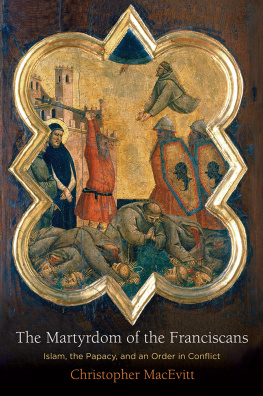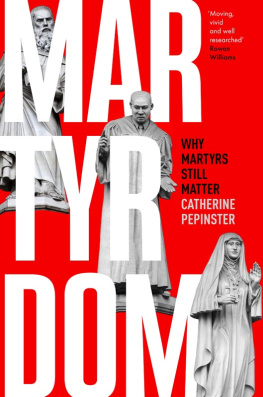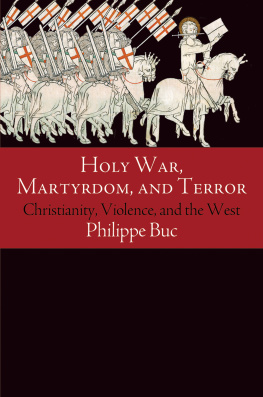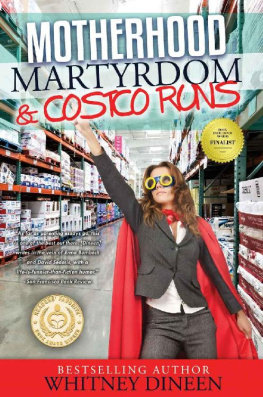
First published 2007 by Paradigm Publishers
Published 2016 by Routledge
2 Park Square, Milton Park, Abingdon, Oxon OX14 4RN
711 Third Avenue, New York, NY 10017, USA
Routledge is an imprint of the Taylor & Francis Group, an informa business
Copyright 2007, Taylor & Francis.
All rights reserved. No part of this book may be reprinted or reproduced or utilised in any form or by any electronic, mechanical, or other means, now known or hereafter invented, including photocopying and recording, or in any information storage or retrieval system, without permission in writing from the publishers.
Notice:
Product or corporate names may be trademarks or registered trademarks, and are used only for identification and explanation without intent to infringe.
Library of Congress Cataloging-in-Publication Data
Barlow, Hugh D.
Dead for good : martyrdom and the rise of the suicide bomber / Hugh Barlow.
p. cm.
Includes bibliographical references and index.
ISBN-13: 978-1-59451-324-4 (hardcover : alk. paper)
ISBN-10: 1-59451-324-4 (hardcover : alk. paper)
ISBN-13: 978-1-59451-325-1 (pbk. : alk. paper)
ISBN-10: 1-59451-325-2 (pbk. : alk. paper)
1. MartyrdomHistory. 2. ViolenceSocial aspectsHistory. I. Title.
BL626.5.B37 2007
363.32512dc22
2006011991
Designed and typeset by Straight Creek Bookmakers.
ISBN 13: 978-1-59451-324-4 (hbk)
ISBN 13: 978-1-59451-325-1 (pbk)
To the memory of Karen Brown
I began research on this book in the fall of 2002, quite unaware that breast cancer would soon take the life of my wife, Karen Brown. She died on September 8, 2004. Karen had encouraged me to write this book and continued to do so during her illness, thinking as usual not of herself but of others. She read every page of the developing manuscript, and her insights were invaluable. There is no way I can adequately put in words all that she meant to me.
Many colleagues and friends read parts of the book, two the entire manuscript: Alice Hall Petry, professor of English language and literature, and Jerry Runkle, emeritus professor of philosophy. I am very grateful for their helpful suggestions, and I hope the end result contains none of the errors they uncovered. I am also thankful for the help and encouragement of John Farley, Steven Fulk, David Kauzlarich, Linda Markowitz, Mike Mikhayel, Danny OMalley, Matt Petrocelli, Lisa Romanowski, Carl Springer, Stephen Tamari, Albert Thompson, and Reem Younis. Other friends I would like to thank for their support and encouragement are Steve and Suzie Castleberry, Doyle Featherston, John and Shirlee Gentles, and Eric Rhein.
It has been a pleasure to work with Dean Birkenkamp and Leslie Lomas of Paradigm Publishers. The copyediting of Julie Kirsch helped make this a much better book.
I owe Colette Biano a special debt for her love, understanding, and timely support as the final chapters took shape.
My children are an inspiration, and now that I am a grandpa, I appreciate all the more the contributions they make to my life. Thank you (in alphabetical order), Alison, Chelsea, Colin, Eric, Kelsey, and Melissa.
At 8:46 on the morning of September 11, 2001, the world changed. Mohamed Atta had just flown an American Airlines Boeing 767 passenger jet into the North Tower of the World Trade Center in New York City. It was 7:46 where I live, and I had one eye on NBCs Today Show as I prepared to leave for work. Stunned by what I saw and heard, I fell into a chair and didnt leave it for hours.
As the months passed and cleanup continued in New York City and at the Pentagon outside Washington, D.C., my thoughts turned to Atta and the eighteen men who had executed the worlds most daring and destructive suicide attack. It turned out that all were Muslims, and fifteen hailed from Saudi Arabia. The mastermind, however, was Kuwait-born Khalid Sheikh Mohammed, a senior al-Qaeda field commander whose nephew, Ramzi Yousef, had tried to blow up the World Trade Center with a truck bomb in 1993. Neither had participated in the actual attacks on 9/11, which al-Qaeda leaders called the Planes Operation.
The suicide-hijackers were hailed as martyrs by some fellow Muslims but most condemned them as evildoers and betrayers of Islam. Around the world, people simply referred to them as terrorists, but with a difference. These al-Qaeda operatives had killed themselves in order to kill others. They died to killliterally. And some people praised them for it. That was hard to understand.
This was not the first time al-Qaeda had used suicide terrorists, nor would it be the last. And al-Qaeda wasnt the only group to send killers to their deaths on behalf of a cause. Militant Palestinian groups were using suicide bombers in the conflict with Israel, and the tactic had been adopted by the Tamil Tigers fighting for independence in Sri Lanka. Nor was this the first time the United States had been attacked by suicide terrorists. Back in 1983, the militant Islamic group Hezbollah, Party of God, had blown up the U.S. embassy in Beirut, Lebanon, and soon afterward American and French military barracks. Then, in August 1998, al-Qaeda used trucks laden with explosives to blow up the U.S. embassies in Nairobi, Kenya, and Dar es Salaam, Tanzania. These attacks killed 231 people, including twelve Americans, and wounded thousands. Two years later, a boat filled with explosives rammed the USS Cole off the coast of Yemen. Seventeen American sailors were killed in this al-Qaeda suicide attack.
Even so, 9/11 stood out for a variety of reasons: the number killedalmost three thousand; the fact that most of the dead were civilians; the method usedturning passenger planes into bombs; the devastation left when the Twin Towers collapsed; the financial cost of the operation to al-Qaeda, the United States, and ultimately, the world; the degree of planning and preparation involved in these attacks, including flight training in the United States and FAA certification of four pilots; the time between origination and consummation of the planwell over two years; the fact that this was the first successful attack on U.S. soil by a foreign organization; and the fact that it was the first destructive attack on the Pentagon. Finally, and perhaps most significantly, the attack did not come as a complete surprise to American intelligence services: Osama bin Laden had declared war on America five years earlier, and he had already ordered suicide attacks against the United States abroad. Intelligence agencies expected an attack on U.S. soil but were uncertain as to where, when, and how. Even so, in its 2004 report, the 9/11 Commission concluded that the United States should have been much better prepared for a devastating attack using suicide terrorists.
If al-Qaeda picked its targets on 9/11 for maximum effect, it could not have done much better. In a taped conversation shortly afterward, Osama bin Laden observed that the collapse of the Twin Towers was unexpected icing on the cake. And pointing to a surge of interest in his religion and many reported conversions, he also said that the martyrs had done a great job for Islam.
The talk of martyrdom and religion in a terrorist context fascinated me. Although one persons terrorist is anothers freedom fighterits all a matter of perspectiveeveryone I talked with and most of what I read did not consider the hijackers to be martyrs. Arent martyrs people who voluntarily die for the Good? These guys looked more like psychotic fanatics. How could martyrdom be consistent with terrorism, I wondered? And how could either advance the interests of a religion? Even though Muslims were implicated in many of the suicide attacks, is religious extremism a necessary element in suicide terrorism? More to the point, is there something about Islam that promotes martyrdom in general and suicide terrorism in particular? And why did so many commentators speak of the martyrs smile? What is there to smile about when you are going to self-destruct and kill women and children in the process?








